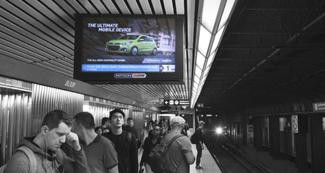Programmatic digital out-of-home (DOOH) advertising has emerged as one of the fastest growing media channels around and is at the helm of the post-pandemic bounce-back.
For us, a DOOH SaaS company, this is exciting news! We actually saw a 30% increase in programmatically transactable screens on our platform, with 75,000 now available worldwide.
But why is this news exciting for marketers?
One of the most promising things about DOOH is the ability to use data triggers to boost the relevance of your outdoor campaigns. And with more DSPs offering access to this dynamic functionality, a growing number of brands are exploring the creative possibilities for the first time!
So what are data triggers? In simple terms, it’s using moments to better contextualize a DOOH campaign. For example, if it’s snowing in Montreal, you can set your creatives to go live on screens with travel ads displaying the temperature in sunny Miami and the time of the next flight out of town.
Ready to start using data to enhance the creativity and effectiveness of your DOOH ad campaigns? We have a few insights and tips for you:
Breaking down data in DOOH
Programmatic DOOH may not offer the same kind of one-to-one targeting you might be used to with online and mobile advertising, but there’s still lots of data available to help you deliver a more relevant message based on the local context and conditions.
When considering what data can be fed into your DOOH campaigns, there are four key categories.
Your audience
Many DOOH networks integrate with mobile data providers to get a historical view of audience demographics and movement around their displays. You can use this data to help decide which screens are the best fit for your campaign.
But for an added layer of context, some DSPs offer a real-time look into who is currently in the area. This can be done with camera sensors that detect things like audience demographics, dwell times, engagement, and more.
The data can then be used to trigger your campaign, should the right conditions be met. For example, a razor company may want to only run their campaign when there is a higher percent of men in the area.
The date and time
This is a fairly simple one, but using the time of the day or the day of the week can significantly improve your campaign’s ROI. Rather than having your campaign run at all times, you can select only moments relevant to your audience and your business.
You can also have different creatives ready depending on the time. For example, a restaurant can display an add for breakfast from 6 AM to 11 AM, a lunch promotion at noon, and an after-work drinks special at 4 PM.
The world
By looking at current world events, you can add a human touch to your campaigns. These triggers can be almost anything that can be delivered by a data feed in real-time, like the weather, stock prices, sports scores, train schedules, and more!
Campbells, for example, used the weather falling below a certain temperature to trigger their hot soup campaign. Flonase purchased OOH inventory when pollen levels rose in particular geographic areas.
[Example: See how Foodora used weather, time of day, and location data to drive a creative, effective, and very relevant programmatic DOOH campaign.]
Your context
While the previous section looked at external events, you can also use internal events to trigger your campaign, as some DSPs offer the ability for you to import your unique data. This can be used to not only deliver a better experience to your audience, but can also be used to optimize your campaign spend.
Supermarket brand Aldi, for example, has used footfall, store sales data and stock availability to refresh and optimize its outdoor creative.
Putting it all together
There are virtually no limits to the kinds of data that can be used to trigger content. By overlaying multiple triggers it becomes possible to get granular with your DOOH targeting in ways that simply weren’t possible until now.
One or more of these data triggers can provide the spark for creative and engaging DOOH ads that not only succeed on their own, but also help boost the performance of your wider omnichannel campaigns.
To find out more about programmatic DOOH, check out our Programmatic U short educational video series and, then, put your newly acquired knowledge to the test with our free Programmatic U certification program.






